Comparing Online and Classroom Learning: Applications of Assessments
VerifiedAdded on 2023/04/23
|10
|2336
|362
Essay
AI Summary
This essay provides a comparative analysis of classroom and online learning environments, with a particular focus on formative and summative assessment methods. It highlights the flexibility of online learning and the importance of physical presence in traditional classrooms. The essay differentiates between formative and summative assessments, noting the role of formative assessments in monitoring student performance during the learning process and summative assessments in evaluating learning outcomes at the end of a unit or semester. It also discusses the practical applications of both assessment types in educational settings, including the use of surveys, feedback, and examinations. The essay concludes by acknowledging the challenges of monitoring performance in online learning and emphasizing the importance of formative assessment in driving students towards academic achievement.

Running head: MANAGEMENT
Compare and contrast between classroom and online applications
Name of the student:
Name of the university:
Author note:
Compare and contrast between classroom and online applications
Name of the student:
Name of the university:
Author note:
Paraphrase This Document
Need a fresh take? Get an instant paraphrase of this document with our AI Paraphraser
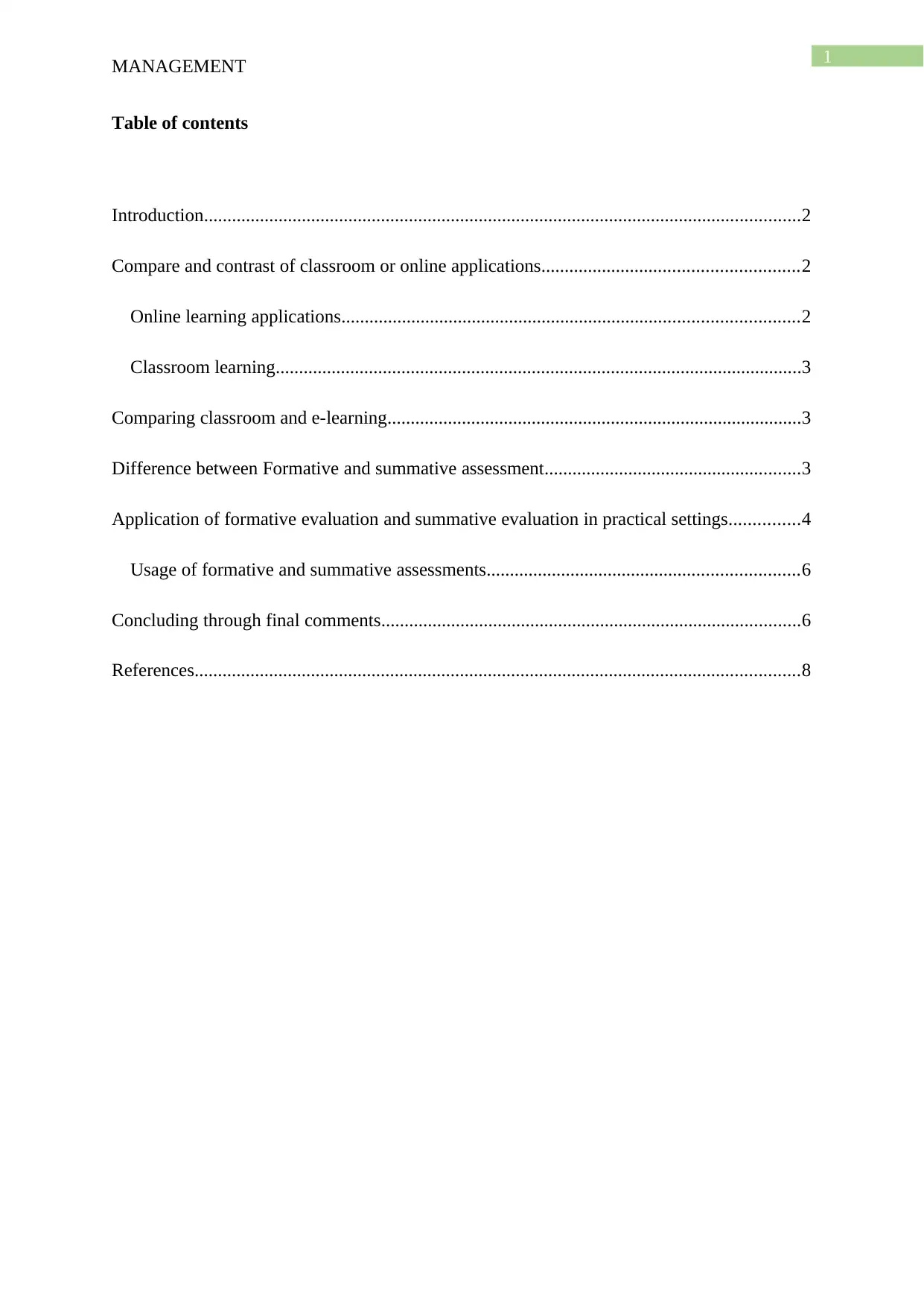
1
MANAGEMENT
Table of contents
Introduction................................................................................................................................2
Compare and contrast of classroom or online applications.......................................................2
Online learning applications..................................................................................................2
Classroom learning.................................................................................................................3
Comparing classroom and e-learning.........................................................................................3
Difference between Formative and summative assessment.......................................................3
Application of formative evaluation and summative evaluation in practical settings...............4
Usage of formative and summative assessments...................................................................6
Concluding through final comments..........................................................................................6
References..................................................................................................................................8
MANAGEMENT
Table of contents
Introduction................................................................................................................................2
Compare and contrast of classroom or online applications.......................................................2
Online learning applications..................................................................................................2
Classroom learning.................................................................................................................3
Comparing classroom and e-learning.........................................................................................3
Difference between Formative and summative assessment.......................................................3
Application of formative evaluation and summative evaluation in practical settings...............4
Usage of formative and summative assessments...................................................................6
Concluding through final comments..........................................................................................6
References..................................................................................................................................8
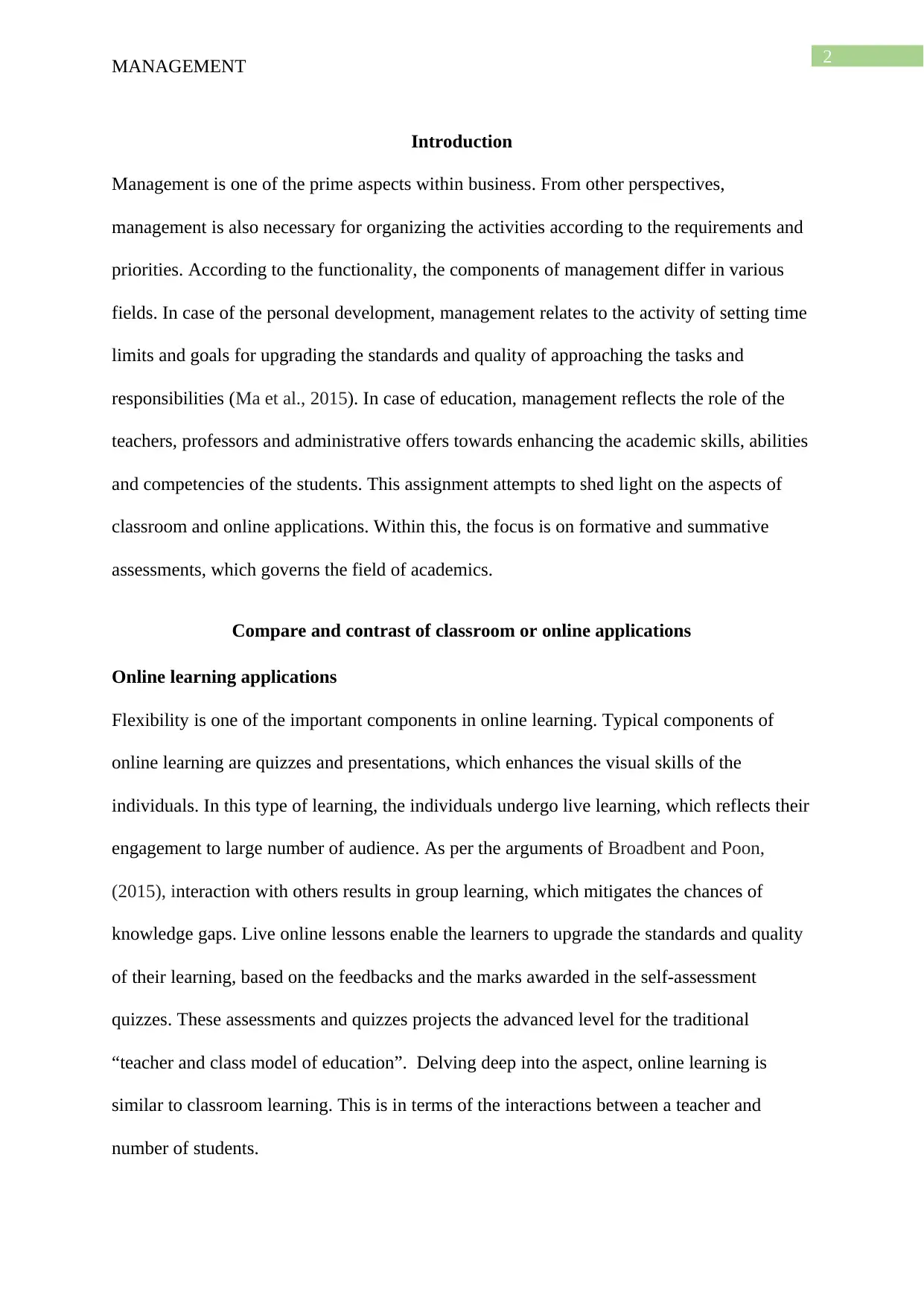
2
MANAGEMENT
Introduction
Management is one of the prime aspects within business. From other perspectives,
management is also necessary for organizing the activities according to the requirements and
priorities. According to the functionality, the components of management differ in various
fields. In case of the personal development, management relates to the activity of setting time
limits and goals for upgrading the standards and quality of approaching the tasks and
responsibilities (Ma et al., 2015). In case of education, management reflects the role of the
teachers, professors and administrative offers towards enhancing the academic skills, abilities
and competencies of the students. This assignment attempts to shed light on the aspects of
classroom and online applications. Within this, the focus is on formative and summative
assessments, which governs the field of academics.
Compare and contrast of classroom or online applications
Online learning applications
Flexibility is one of the important components in online learning. Typical components of
online learning are quizzes and presentations, which enhances the visual skills of the
individuals. In this type of learning, the individuals undergo live learning, which reflects their
engagement to large number of audience. As per the arguments of Broadbent and Poon,
(2015), interaction with others results in group learning, which mitigates the chances of
knowledge gaps. Live online lessons enable the learners to upgrade the standards and quality
of their learning, based on the feedbacks and the marks awarded in the self-assessment
quizzes. These assessments and quizzes projects the advanced level for the traditional
“teacher and class model of education”. Delving deep into the aspect, online learning is
similar to classroom learning. This is in terms of the interactions between a teacher and
number of students.
MANAGEMENT
Introduction
Management is one of the prime aspects within business. From other perspectives,
management is also necessary for organizing the activities according to the requirements and
priorities. According to the functionality, the components of management differ in various
fields. In case of the personal development, management relates to the activity of setting time
limits and goals for upgrading the standards and quality of approaching the tasks and
responsibilities (Ma et al., 2015). In case of education, management reflects the role of the
teachers, professors and administrative offers towards enhancing the academic skills, abilities
and competencies of the students. This assignment attempts to shed light on the aspects of
classroom and online applications. Within this, the focus is on formative and summative
assessments, which governs the field of academics.
Compare and contrast of classroom or online applications
Online learning applications
Flexibility is one of the important components in online learning. Typical components of
online learning are quizzes and presentations, which enhances the visual skills of the
individuals. In this type of learning, the individuals undergo live learning, which reflects their
engagement to large number of audience. As per the arguments of Broadbent and Poon,
(2015), interaction with others results in group learning, which mitigates the chances of
knowledge gaps. Live online lessons enable the learners to upgrade the standards and quality
of their learning, based on the feedbacks and the marks awarded in the self-assessment
quizzes. These assessments and quizzes projects the advanced level for the traditional
“teacher and class model of education”. Delving deep into the aspect, online learning is
similar to classroom learning. This is in terms of the interactions between a teacher and
number of students.
⊘ This is a preview!⊘
Do you want full access?
Subscribe today to unlock all pages.

Trusted by 1+ million students worldwide
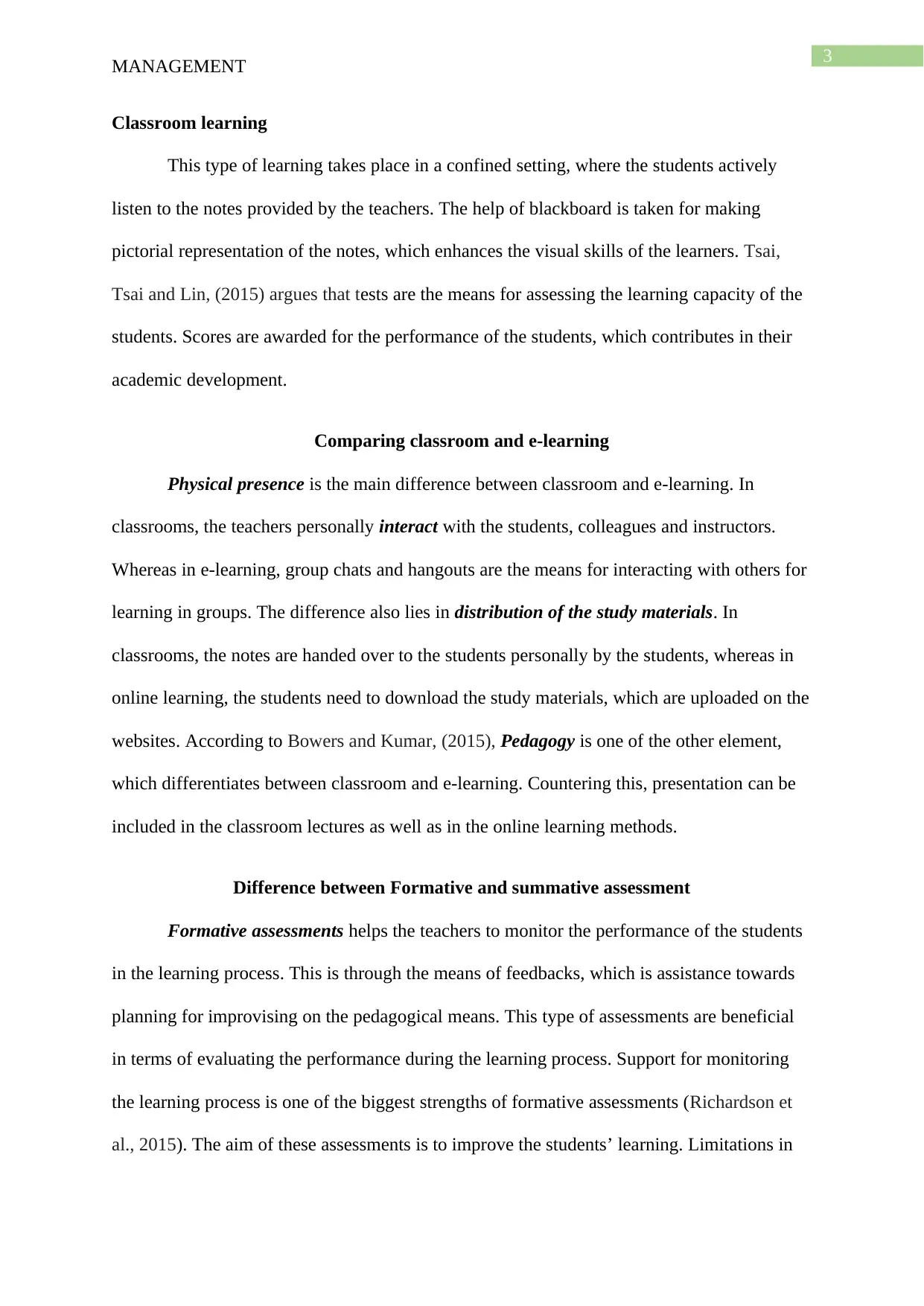
3
MANAGEMENT
Classroom learning
This type of learning takes place in a confined setting, where the students actively
listen to the notes provided by the teachers. The help of blackboard is taken for making
pictorial representation of the notes, which enhances the visual skills of the learners. Tsai,
Tsai and Lin, (2015) argues that tests are the means for assessing the learning capacity of the
students. Scores are awarded for the performance of the students, which contributes in their
academic development.
Comparing classroom and e-learning
Physical presence is the main difference between classroom and e-learning. In
classrooms, the teachers personally interact with the students, colleagues and instructors.
Whereas in e-learning, group chats and hangouts are the means for interacting with others for
learning in groups. The difference also lies in distribution of the study materials. In
classrooms, the notes are handed over to the students personally by the students, whereas in
online learning, the students need to download the study materials, which are uploaded on the
websites. According to Bowers and Kumar, (2015), Pedagogy is one of the other element,
which differentiates between classroom and e-learning. Countering this, presentation can be
included in the classroom lectures as well as in the online learning methods.
Difference between Formative and summative assessment
Formative assessments helps the teachers to monitor the performance of the students
in the learning process. This is through the means of feedbacks, which is assistance towards
planning for improvising on the pedagogical means. This type of assessments are beneficial
in terms of evaluating the performance during the learning process. Support for monitoring
the learning process is one of the biggest strengths of formative assessments (Richardson et
al., 2015). The aim of these assessments is to improve the students’ learning. Limitations in
MANAGEMENT
Classroom learning
This type of learning takes place in a confined setting, where the students actively
listen to the notes provided by the teachers. The help of blackboard is taken for making
pictorial representation of the notes, which enhances the visual skills of the learners. Tsai,
Tsai and Lin, (2015) argues that tests are the means for assessing the learning capacity of the
students. Scores are awarded for the performance of the students, which contributes in their
academic development.
Comparing classroom and e-learning
Physical presence is the main difference between classroom and e-learning. In
classrooms, the teachers personally interact with the students, colleagues and instructors.
Whereas in e-learning, group chats and hangouts are the means for interacting with others for
learning in groups. The difference also lies in distribution of the study materials. In
classrooms, the notes are handed over to the students personally by the students, whereas in
online learning, the students need to download the study materials, which are uploaded on the
websites. According to Bowers and Kumar, (2015), Pedagogy is one of the other element,
which differentiates between classroom and e-learning. Countering this, presentation can be
included in the classroom lectures as well as in the online learning methods.
Difference between Formative and summative assessment
Formative assessments helps the teachers to monitor the performance of the students
in the learning process. This is through the means of feedbacks, which is assistance towards
planning for improvising on the pedagogical means. This type of assessments are beneficial
in terms of evaluating the performance during the learning process. Support for monitoring
the learning process is one of the biggest strengths of formative assessments (Richardson et
al., 2015). The aim of these assessments is to improve the students’ learning. Limitations in
Paraphrase This Document
Need a fresh take? Get an instant paraphrase of this document with our AI Paraphraser
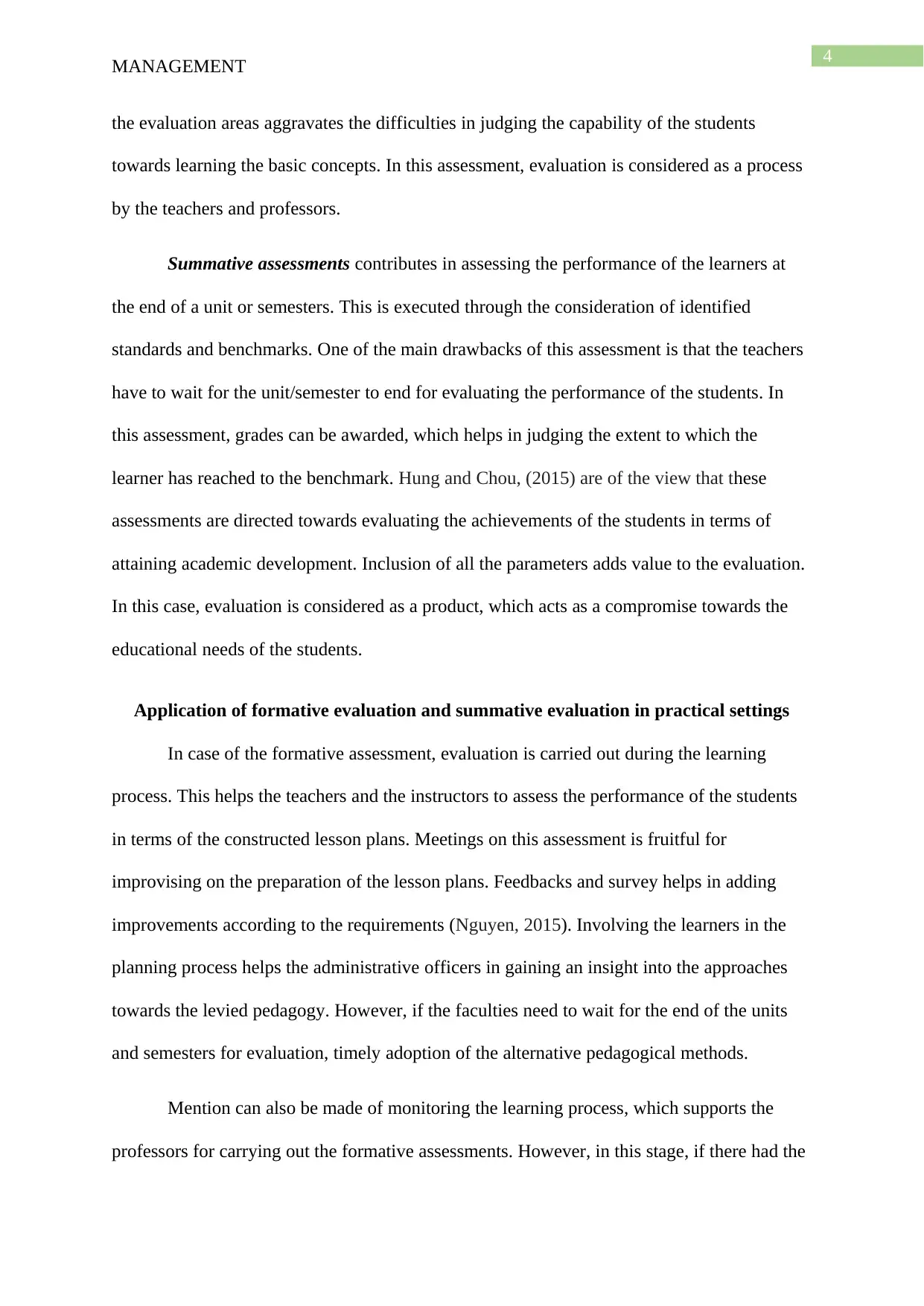
4
MANAGEMENT
the evaluation areas aggravates the difficulties in judging the capability of the students
towards learning the basic concepts. In this assessment, evaluation is considered as a process
by the teachers and professors.
Summative assessments contributes in assessing the performance of the learners at
the end of a unit or semesters. This is executed through the consideration of identified
standards and benchmarks. One of the main drawbacks of this assessment is that the teachers
have to wait for the unit/semester to end for evaluating the performance of the students. In
this assessment, grades can be awarded, which helps in judging the extent to which the
learner has reached to the benchmark. Hung and Chou, (2015) are of the view that these
assessments are directed towards evaluating the achievements of the students in terms of
attaining academic development. Inclusion of all the parameters adds value to the evaluation.
In this case, evaluation is considered as a product, which acts as a compromise towards the
educational needs of the students.
Application of formative evaluation and summative evaluation in practical settings
In case of the formative assessment, evaluation is carried out during the learning
process. This helps the teachers and the instructors to assess the performance of the students
in terms of the constructed lesson plans. Meetings on this assessment is fruitful for
improvising on the preparation of the lesson plans. Feedbacks and survey helps in adding
improvements according to the requirements (Nguyen, 2015). Involving the learners in the
planning process helps the administrative officers in gaining an insight into the approaches
towards the levied pedagogy. However, if the faculties need to wait for the end of the units
and semesters for evaluation, timely adoption of the alternative pedagogical methods.
Mention can also be made of monitoring the learning process, which supports the
professors for carrying out the formative assessments. However, in this stage, if there had the
MANAGEMENT
the evaluation areas aggravates the difficulties in judging the capability of the students
towards learning the basic concepts. In this assessment, evaluation is considered as a process
by the teachers and professors.
Summative assessments contributes in assessing the performance of the learners at
the end of a unit or semesters. This is executed through the consideration of identified
standards and benchmarks. One of the main drawbacks of this assessment is that the teachers
have to wait for the unit/semester to end for evaluating the performance of the students. In
this assessment, grades can be awarded, which helps in judging the extent to which the
learner has reached to the benchmark. Hung and Chou, (2015) are of the view that these
assessments are directed towards evaluating the achievements of the students in terms of
attaining academic development. Inclusion of all the parameters adds value to the evaluation.
In this case, evaluation is considered as a product, which acts as a compromise towards the
educational needs of the students.
Application of formative evaluation and summative evaluation in practical settings
In case of the formative assessment, evaluation is carried out during the learning
process. This helps the teachers and the instructors to assess the performance of the students
in terms of the constructed lesson plans. Meetings on this assessment is fruitful for
improvising on the preparation of the lesson plans. Feedbacks and survey helps in adding
improvements according to the requirements (Nguyen, 2015). Involving the learners in the
planning process helps the administrative officers in gaining an insight into the approaches
towards the levied pedagogy. However, if the faculties need to wait for the end of the units
and semesters for evaluation, timely adoption of the alternative pedagogical methods.
Mention can also be made of monitoring the learning process, which supports the
professors for carrying out the formative assessments. However, in this stage, if there had the
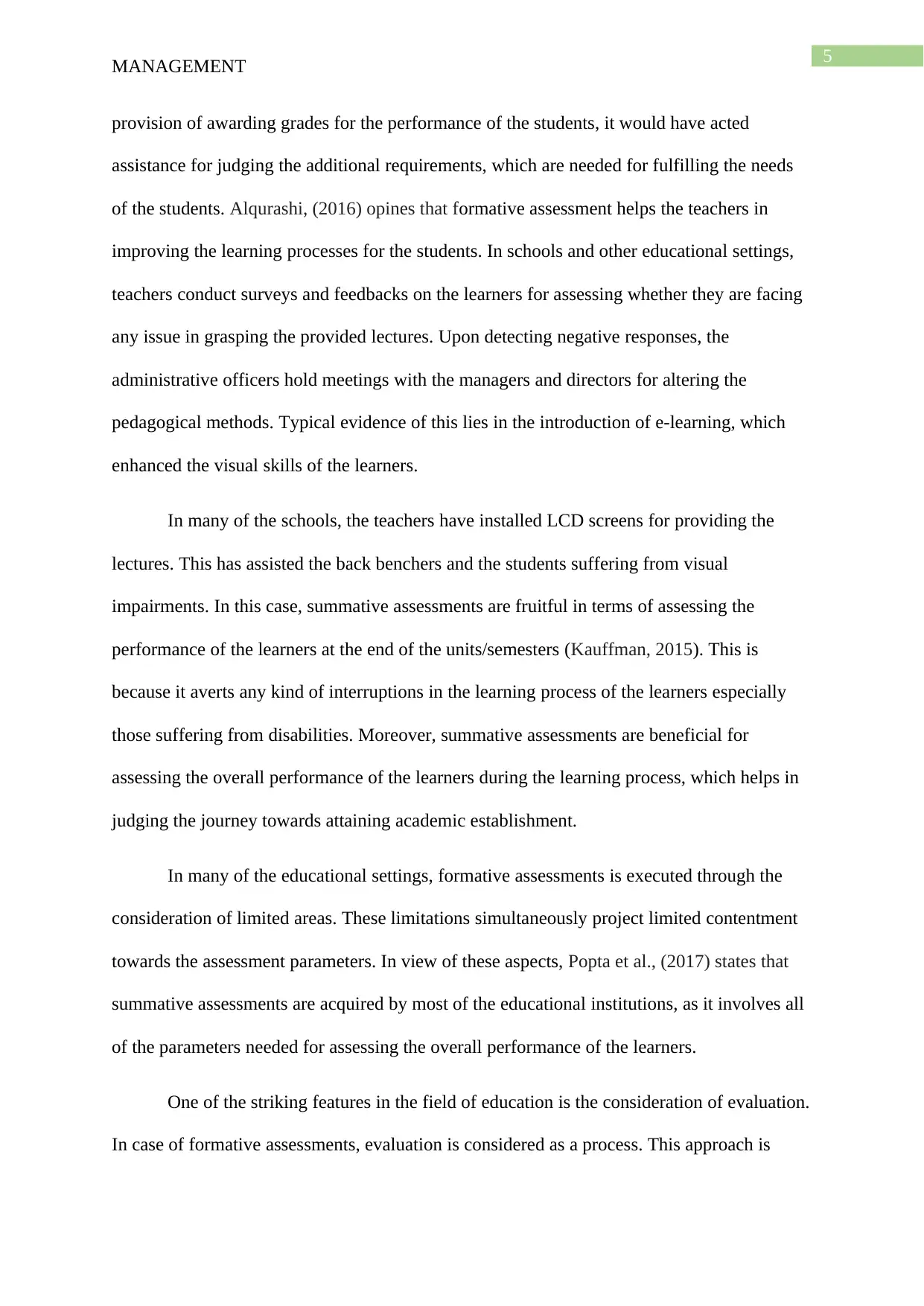
5
MANAGEMENT
provision of awarding grades for the performance of the students, it would have acted
assistance for judging the additional requirements, which are needed for fulfilling the needs
of the students. Alqurashi, (2016) opines that formative assessment helps the teachers in
improving the learning processes for the students. In schools and other educational settings,
teachers conduct surveys and feedbacks on the learners for assessing whether they are facing
any issue in grasping the provided lectures. Upon detecting negative responses, the
administrative officers hold meetings with the managers and directors for altering the
pedagogical methods. Typical evidence of this lies in the introduction of e-learning, which
enhanced the visual skills of the learners.
In many of the schools, the teachers have installed LCD screens for providing the
lectures. This has assisted the back benchers and the students suffering from visual
impairments. In this case, summative assessments are fruitful in terms of assessing the
performance of the learners at the end of the units/semesters (Kauffman, 2015). This is
because it averts any kind of interruptions in the learning process of the learners especially
those suffering from disabilities. Moreover, summative assessments are beneficial for
assessing the overall performance of the learners during the learning process, which helps in
judging the journey towards attaining academic establishment.
In many of the educational settings, formative assessments is executed through the
consideration of limited areas. These limitations simultaneously project limited contentment
towards the assessment parameters. In view of these aspects, Popta et al., (2017) states that
summative assessments are acquired by most of the educational institutions, as it involves all
of the parameters needed for assessing the overall performance of the learners.
One of the striking features in the field of education is the consideration of evaluation.
In case of formative assessments, evaluation is considered as a process. This approach is
MANAGEMENT
provision of awarding grades for the performance of the students, it would have acted
assistance for judging the additional requirements, which are needed for fulfilling the needs
of the students. Alqurashi, (2016) opines that formative assessment helps the teachers in
improving the learning processes for the students. In schools and other educational settings,
teachers conduct surveys and feedbacks on the learners for assessing whether they are facing
any issue in grasping the provided lectures. Upon detecting negative responses, the
administrative officers hold meetings with the managers and directors for altering the
pedagogical methods. Typical evidence of this lies in the introduction of e-learning, which
enhanced the visual skills of the learners.
In many of the schools, the teachers have installed LCD screens for providing the
lectures. This has assisted the back benchers and the students suffering from visual
impairments. In this case, summative assessments are fruitful in terms of assessing the
performance of the learners at the end of the units/semesters (Kauffman, 2015). This is
because it averts any kind of interruptions in the learning process of the learners especially
those suffering from disabilities. Moreover, summative assessments are beneficial for
assessing the overall performance of the learners during the learning process, which helps in
judging the journey towards attaining academic establishment.
In many of the educational settings, formative assessments is executed through the
consideration of limited areas. These limitations simultaneously project limited contentment
towards the assessment parameters. In view of these aspects, Popta et al., (2017) states that
summative assessments are acquired by most of the educational institutions, as it involves all
of the parameters needed for assessing the overall performance of the learners.
One of the striking features in the field of education is the consideration of evaluation.
In case of formative assessments, evaluation is considered as a process. This approach is
⊘ This is a preview!⊘
Do you want full access?
Subscribe today to unlock all pages.

Trusted by 1+ million students worldwide
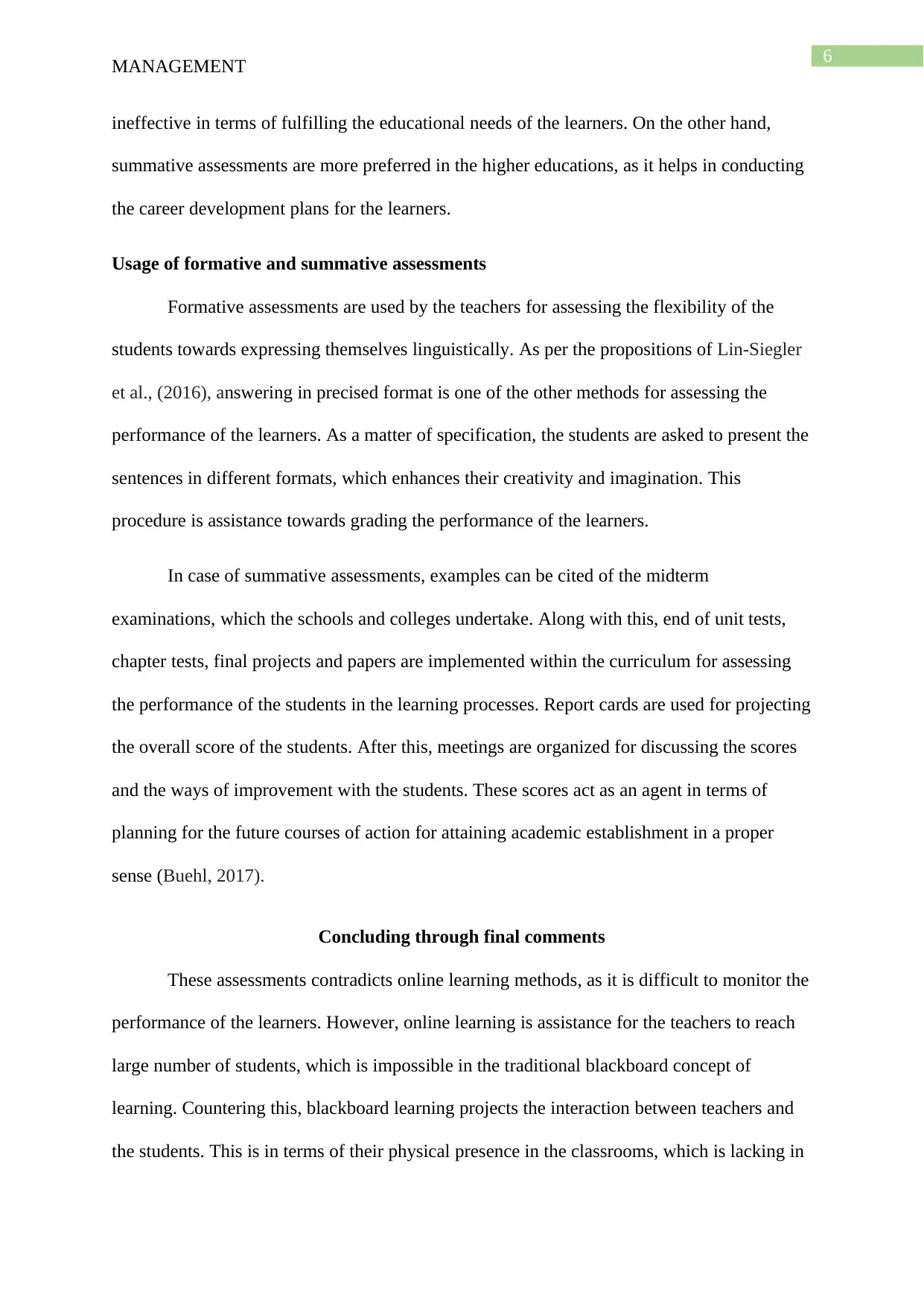
6
MANAGEMENT
ineffective in terms of fulfilling the educational needs of the learners. On the other hand,
summative assessments are more preferred in the higher educations, as it helps in conducting
the career development plans for the learners.
Usage of formative and summative assessments
Formative assessments are used by the teachers for assessing the flexibility of the
students towards expressing themselves linguistically. As per the propositions of Lin-Siegler
et al., (2016), answering in precised format is one of the other methods for assessing the
performance of the learners. As a matter of specification, the students are asked to present the
sentences in different formats, which enhances their creativity and imagination. This
procedure is assistance towards grading the performance of the learners.
In case of summative assessments, examples can be cited of the midterm
examinations, which the schools and colleges undertake. Along with this, end of unit tests,
chapter tests, final projects and papers are implemented within the curriculum for assessing
the performance of the students in the learning processes. Report cards are used for projecting
the overall score of the students. After this, meetings are organized for discussing the scores
and the ways of improvement with the students. These scores act as an agent in terms of
planning for the future courses of action for attaining academic establishment in a proper
sense (Buehl, 2017).
Concluding through final comments
These assessments contradicts online learning methods, as it is difficult to monitor the
performance of the learners. However, online learning is assistance for the teachers to reach
large number of students, which is impossible in the traditional blackboard concept of
learning. Countering this, blackboard learning projects the interaction between teachers and
the students. This is in terms of their physical presence in the classrooms, which is lacking in
MANAGEMENT
ineffective in terms of fulfilling the educational needs of the learners. On the other hand,
summative assessments are more preferred in the higher educations, as it helps in conducting
the career development plans for the learners.
Usage of formative and summative assessments
Formative assessments are used by the teachers for assessing the flexibility of the
students towards expressing themselves linguistically. As per the propositions of Lin-Siegler
et al., (2016), answering in precised format is one of the other methods for assessing the
performance of the learners. As a matter of specification, the students are asked to present the
sentences in different formats, which enhances their creativity and imagination. This
procedure is assistance towards grading the performance of the learners.
In case of summative assessments, examples can be cited of the midterm
examinations, which the schools and colleges undertake. Along with this, end of unit tests,
chapter tests, final projects and papers are implemented within the curriculum for assessing
the performance of the students in the learning processes. Report cards are used for projecting
the overall score of the students. After this, meetings are organized for discussing the scores
and the ways of improvement with the students. These scores act as an agent in terms of
planning for the future courses of action for attaining academic establishment in a proper
sense (Buehl, 2017).
Concluding through final comments
These assessments contradicts online learning methods, as it is difficult to monitor the
performance of the learners. However, online learning is assistance for the teachers to reach
large number of students, which is impossible in the traditional blackboard concept of
learning. Countering this, blackboard learning projects the interaction between teachers and
the students. This is in terms of their physical presence in the classrooms, which is lacking in
Paraphrase This Document
Need a fresh take? Get an instant paraphrase of this document with our AI Paraphraser
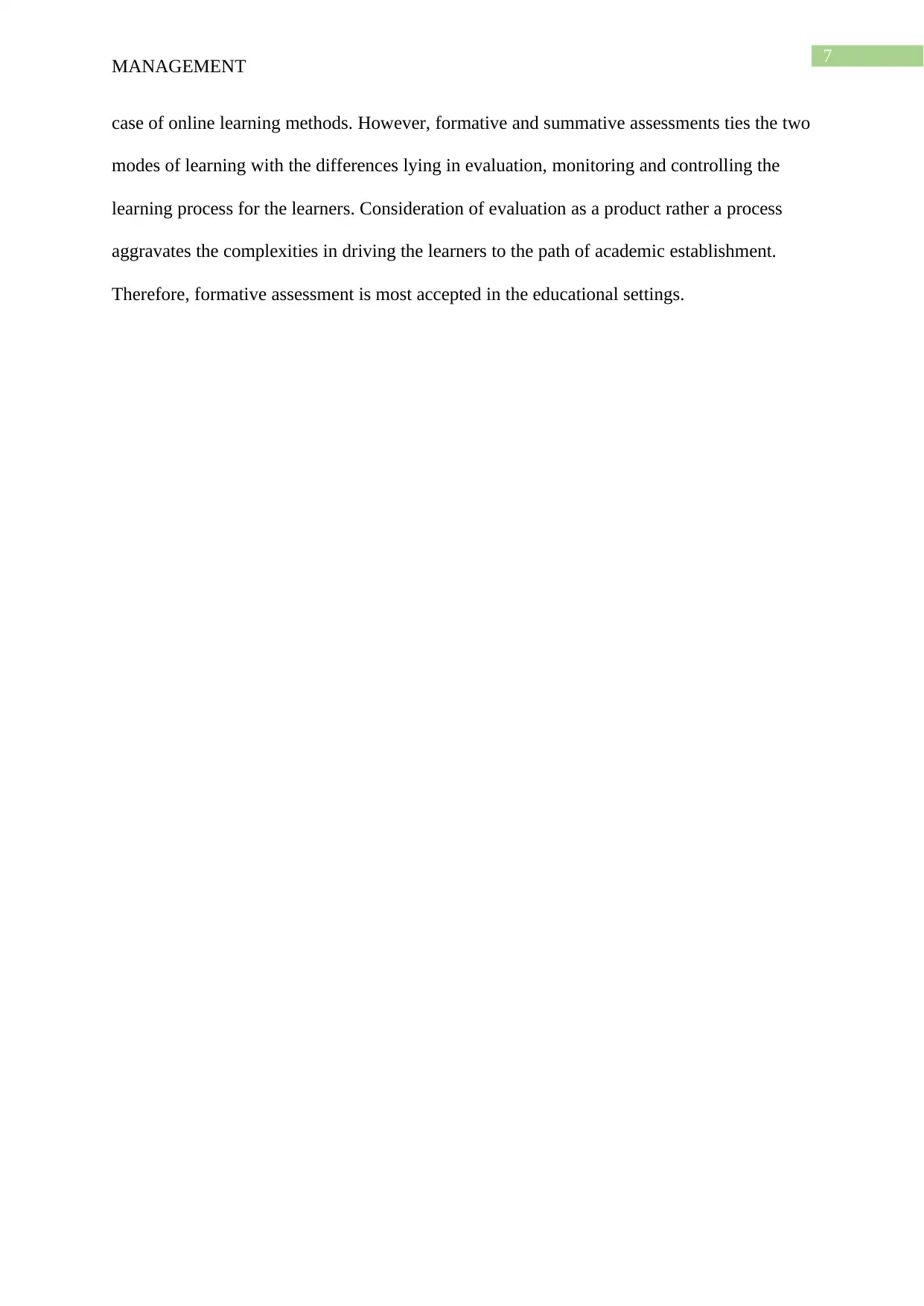
7
MANAGEMENT
case of online learning methods. However, formative and summative assessments ties the two
modes of learning with the differences lying in evaluation, monitoring and controlling the
learning process for the learners. Consideration of evaluation as a product rather a process
aggravates the complexities in driving the learners to the path of academic establishment.
Therefore, formative assessment is most accepted in the educational settings.
MANAGEMENT
case of online learning methods. However, formative and summative assessments ties the two
modes of learning with the differences lying in evaluation, monitoring and controlling the
learning process for the learners. Consideration of evaluation as a product rather a process
aggravates the complexities in driving the learners to the path of academic establishment.
Therefore, formative assessment is most accepted in the educational settings.
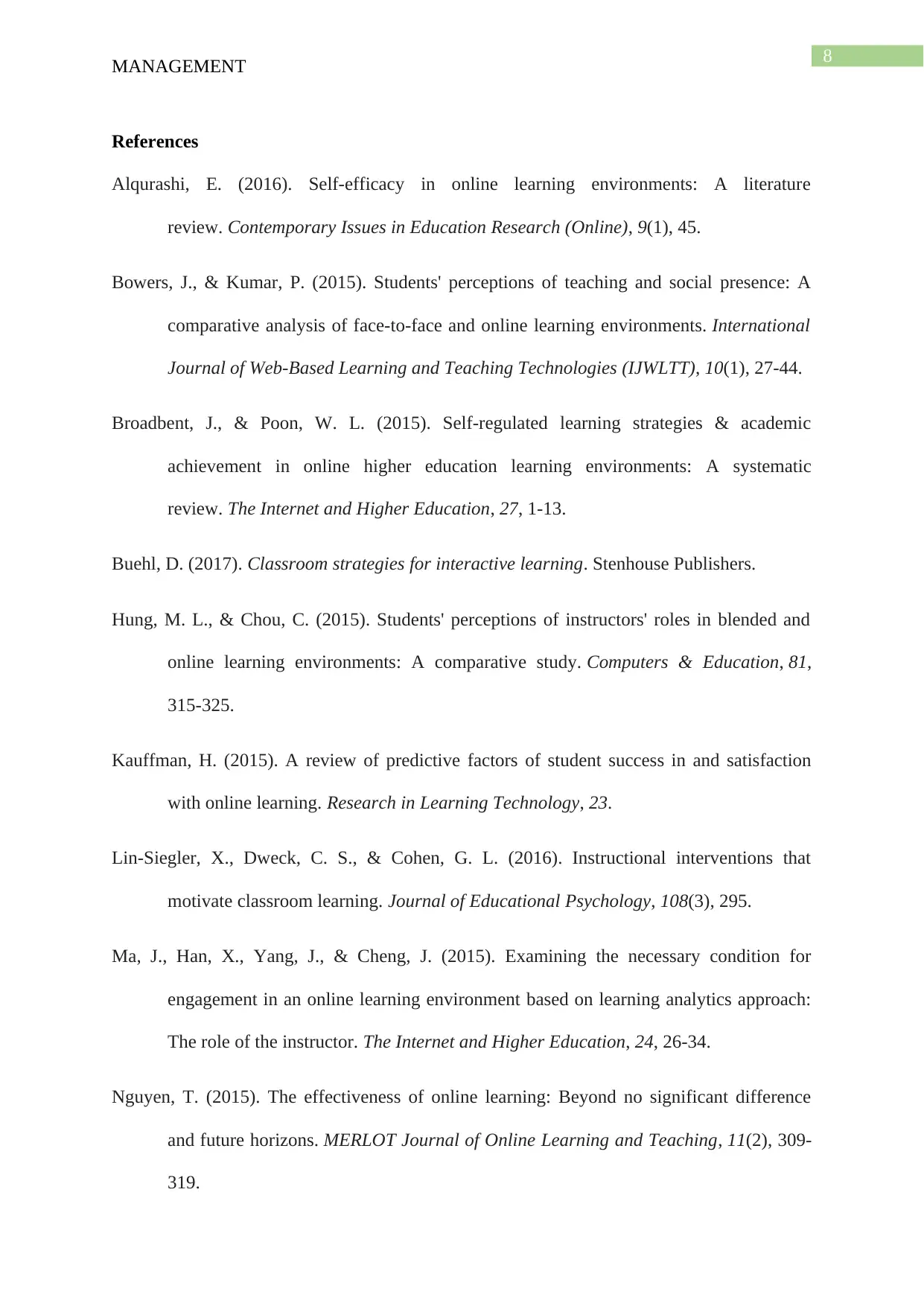
8
MANAGEMENT
References
Alqurashi, E. (2016). Self-efficacy in online learning environments: A literature
review. Contemporary Issues in Education Research (Online), 9(1), 45.
Bowers, J., & Kumar, P. (2015). Students' perceptions of teaching and social presence: A
comparative analysis of face-to-face and online learning environments. International
Journal of Web-Based Learning and Teaching Technologies (IJWLTT), 10(1), 27-44.
Broadbent, J., & Poon, W. L. (2015). Self-regulated learning strategies & academic
achievement in online higher education learning environments: A systematic
review. The Internet and Higher Education, 27, 1-13.
Buehl, D. (2017). Classroom strategies for interactive learning. Stenhouse Publishers.
Hung, M. L., & Chou, C. (2015). Students' perceptions of instructors' roles in blended and
online learning environments: A comparative study. Computers & Education, 81,
315-325.
Kauffman, H. (2015). A review of predictive factors of student success in and satisfaction
with online learning. Research in Learning Technology, 23.
Lin-Siegler, X., Dweck, C. S., & Cohen, G. L. (2016). Instructional interventions that
motivate classroom learning. Journal of Educational Psychology, 108(3), 295.
Ma, J., Han, X., Yang, J., & Cheng, J. (2015). Examining the necessary condition for
engagement in an online learning environment based on learning analytics approach:
The role of the instructor. The Internet and Higher Education, 24, 26-34.
Nguyen, T. (2015). The effectiveness of online learning: Beyond no significant difference
and future horizons. MERLOT Journal of Online Learning and Teaching, 11(2), 309-
319.
MANAGEMENT
References
Alqurashi, E. (2016). Self-efficacy in online learning environments: A literature
review. Contemporary Issues in Education Research (Online), 9(1), 45.
Bowers, J., & Kumar, P. (2015). Students' perceptions of teaching and social presence: A
comparative analysis of face-to-face and online learning environments. International
Journal of Web-Based Learning and Teaching Technologies (IJWLTT), 10(1), 27-44.
Broadbent, J., & Poon, W. L. (2015). Self-regulated learning strategies & academic
achievement in online higher education learning environments: A systematic
review. The Internet and Higher Education, 27, 1-13.
Buehl, D. (2017). Classroom strategies for interactive learning. Stenhouse Publishers.
Hung, M. L., & Chou, C. (2015). Students' perceptions of instructors' roles in blended and
online learning environments: A comparative study. Computers & Education, 81,
315-325.
Kauffman, H. (2015). A review of predictive factors of student success in and satisfaction
with online learning. Research in Learning Technology, 23.
Lin-Siegler, X., Dweck, C. S., & Cohen, G. L. (2016). Instructional interventions that
motivate classroom learning. Journal of Educational Psychology, 108(3), 295.
Ma, J., Han, X., Yang, J., & Cheng, J. (2015). Examining the necessary condition for
engagement in an online learning environment based on learning analytics approach:
The role of the instructor. The Internet and Higher Education, 24, 26-34.
Nguyen, T. (2015). The effectiveness of online learning: Beyond no significant difference
and future horizons. MERLOT Journal of Online Learning and Teaching, 11(2), 309-
319.
⊘ This is a preview!⊘
Do you want full access?
Subscribe today to unlock all pages.

Trusted by 1+ million students worldwide
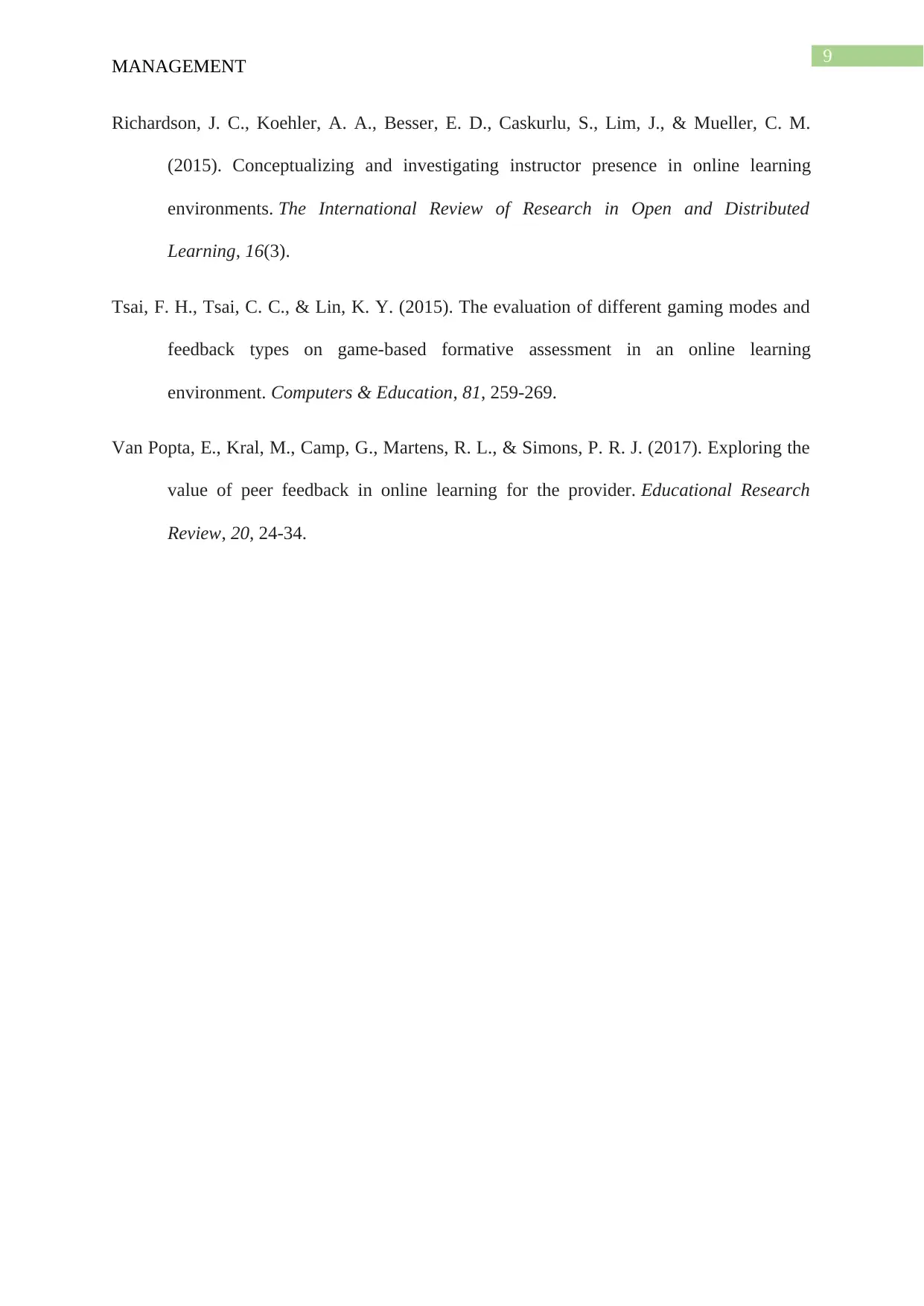
9
MANAGEMENT
Richardson, J. C., Koehler, A. A., Besser, E. D., Caskurlu, S., Lim, J., & Mueller, C. M.
(2015). Conceptualizing and investigating instructor presence in online learning
environments. The International Review of Research in Open and Distributed
Learning, 16(3).
Tsai, F. H., Tsai, C. C., & Lin, K. Y. (2015). The evaluation of different gaming modes and
feedback types on game-based formative assessment in an online learning
environment. Computers & Education, 81, 259-269.
Van Popta, E., Kral, M., Camp, G., Martens, R. L., & Simons, P. R. J. (2017). Exploring the
value of peer feedback in online learning for the provider. Educational Research
Review, 20, 24-34.
MANAGEMENT
Richardson, J. C., Koehler, A. A., Besser, E. D., Caskurlu, S., Lim, J., & Mueller, C. M.
(2015). Conceptualizing and investigating instructor presence in online learning
environments. The International Review of Research in Open and Distributed
Learning, 16(3).
Tsai, F. H., Tsai, C. C., & Lin, K. Y. (2015). The evaluation of different gaming modes and
feedback types on game-based formative assessment in an online learning
environment. Computers & Education, 81, 259-269.
Van Popta, E., Kral, M., Camp, G., Martens, R. L., & Simons, P. R. J. (2017). Exploring the
value of peer feedback in online learning for the provider. Educational Research
Review, 20, 24-34.
1 out of 10
Related Documents
Your All-in-One AI-Powered Toolkit for Academic Success.
+13062052269
info@desklib.com
Available 24*7 on WhatsApp / Email
![[object Object]](/_next/static/media/star-bottom.7253800d.svg)
Unlock your academic potential
Copyright © 2020–2025 A2Z Services. All Rights Reserved. Developed and managed by ZUCOL.



